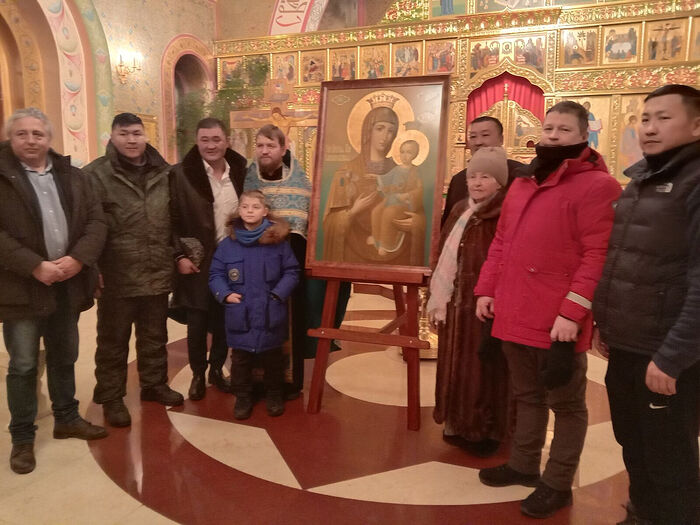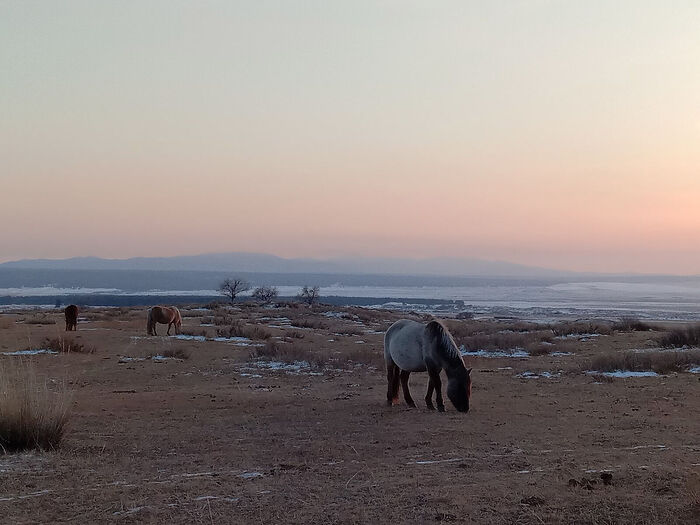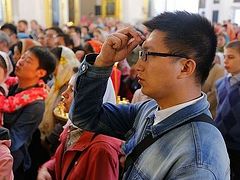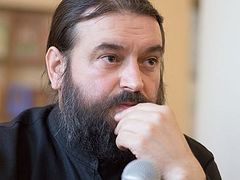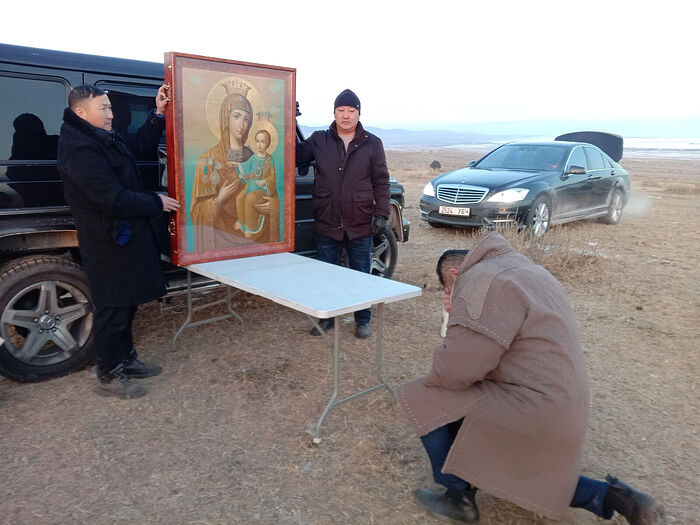 Meeting of the icon in the Mongolian desert
Meeting of the icon in the Mongolian desert
The faithful of Mongolia believe that the Russian Holy Trinity parish in Ulaanbaatar, and indeed all Orthodox Mongolians, received a Christmas present from the Queen of Heaven Herself,.
There is an inscription on the reverse side of the icon saying that it was sent “as a gift... to all Russians and Orthodox, residing in Urga and throughout Mongolia permanently or temporarily... Or to the future magnificent church in Urga.” The inscription (and the icon itself) dates back to the late nineteenth century—when the Russian consulate opened in Mongolia. During the tragic events of the twentieth century the Orthodox church in Urga was destroyed, its priest was killed, and the icon ended up at the National Museum of the Buryat Republic.1 Now that the marvelous Holy Trinity Church has been built in Ulaanbaatar (as ancient Urga is called today) through the efforts of our Orthodox missionary priests and numerous benefactors from Russia and Mongolia, and regular services are celebrated there, it has been decided restore spiritual and historical justice by returning the icon to the place for which it was intended.
“It would have been impossible to do it through our own efforts,” says the rector of the Holy Trinity Church in Ulaanbaatar, Priest Anthony Gusev. “Our desire, however justified, is one thing, but whether there is the will of God and the blessing of the Queen of Heaven is quite another. Not a single good deed is done without temptations and trials, and we have added evidence of this. As it turns out, despite all our efforts and requests it is impossible to return the original icon to Mongolia. This is because Russia’s cultural heritage, which of course includes the ‘Self-Painted’ Icon, cannot be taken to a foreign organization; our Holy Trinity parish in Ulaanbaatar happens to be a foreign organization. The bureaucratic difficulties seemed insurmountable. However, with the blessing of the Mother of God we managed to have an exact copy of this icon completed last summer. It was created by the artists Ivan Kuznetsov and Eugene Kravtsov, teachers of the Moscow Art Academy. They first worked at the National Museum of Buryatia, and then completed their work in Moscow. And at the end of the year, just before the Nativity, we made a pilgrimage with the icon of the Mother of God. We set off from Moscow and traveled through Irkutsk, the Posolskoye Holy Transfiguration Monastery on Baikal, Ulan-Ude, Gusinoozersk, Kyakhta and beyond the Mongolian border. It was a real pilgrimage! As we travelled we saw that Orthodoxy here is not just a tradition, but life itself. We were convinced that Christianity is alive in Russia. Christ is loved even in faraway Mongolia. I can talk about our journey for hours, but for now I will say only one thing: We saw both the will of God and the blessing of the Mother of God to continue our service in Mongolia.”
Metropolitan Anthony of Volokolamsk, Chairman of the Department for External Church Relations, instructed the pilgrims at the Liturgy in the Church of the Nativity of John the Baptist in Moscow before they set off:
“This icon of the Queen of Heaven has a special history. Painted at the request of monks from Holy Mount Athos, in the nineteenth century it was sent to Mongolia and China as a sign of prayerful support to the Christians in Urga. Unfortunately, the tragic events—the coup d’etat in Russia and civil wars in Russia and neighboring countries—prevented the icon from being delivered to Mongolia. Now the original is at the National Museum of the Republic of Buryatia. Through the work of philanthropists and patrons who are not indifferent to the history of Orthodoxy in Mongolia an exact copy of this icon was recently painted and kept at the Church of the Nativity of John the Baptist in Presnya for several months. The icon was in the altar, services were celebrated in front of it, and today we bid farewell to it, sending the icon to place where it the Athonite monks intended it to be: Mongolia.”
I know that the arrival of the icon of the Mother of God in Urga and its stay in Mongolia will be a great consolation for all Christians in this country—parishioners of the Holy Trinity Church in Ulaanbaatar and everyone else. I also know that the life of the Orthodox community in Mongolia is not easy, that there are many difficulties, and I hope that the blessing of the Queen of Heaven, which we see in this icon, will become a great support and consolation for all Orthodox in Mongolia. I think that both historical and spiritual justice will be restored in this way, and the preaching of Christ will be heard by as many Mongolians as possible.
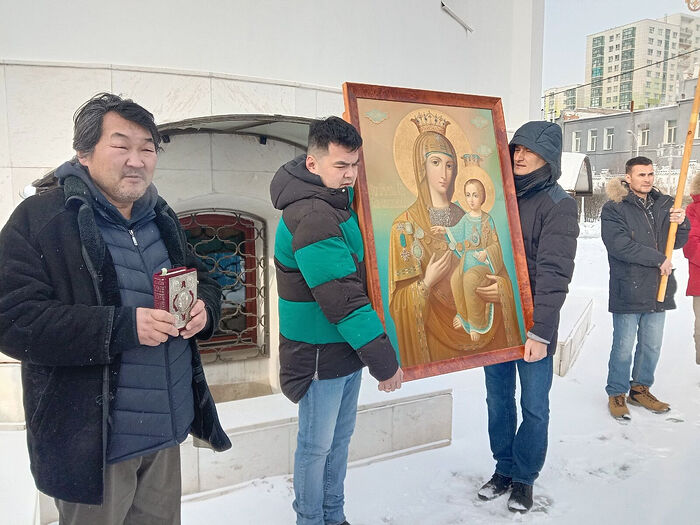 At the Holy Trinity Church in Ulaanbaatar
At the Holy Trinity Church in Ulaanbaatar
After the solemn service in Buryatia, Metropolitan Joseph of Ulan-Ude and Buryatia shared his thoughts on the meaning and purpose of the icon of the Mother of God in Urga:
“We have become participants in a very significant spiritual event. What is an icon for Orthodox people? We believe that through each of Her icons the Queen of Heaven gives us grace and strength. The wind bloweth where it listeth (Jn. 3:8), and the kind of power with which one or another icon is endowed depends on God, and not human will. Here is an illustration: We take a candle and light it from an already burning candle, and this second candle might burn stronger and clearer than the one from which it was lit. Now this grace-filled power depends on the will of the Queen of Heaven. She pours out grace to all who pray with faith before the holy icon. This event is truly important and significant: A new, exact copy of the wonderworking ‘Self-Painted’ Icon has been made. This is one of the youngest icons of Mt. Athos. After all, there are very ancient venerated icons, such as the Iveron and ‘Sweet-Kissing’ that were painted even before the iconoclast persecution in the eighth century. And the icon, the exact copy of which we now see, was painted in the same year when the consulate of the Russian Empire in Urga opened, in 1863—that is, not so long ago. We know that the ‘Self-Painted’ Icon was venerated in Mongolia, processions were arranged with it, and miracles were recorded. Thus, when the Transbaikalian missionary Archpriest Sergei Znamensky (1879–1937; commemorated November 14)—a future New Martyr—served in Mongolia, he held processions with this icon. It so happened that because of our sins, relics were destroyed, churches were closed and demolished, and persecution of the Church began. But the icon was preserved, and now its exact copy has been created—thus a candle has been lit from a candle to shine in the Orthodox world. Such examples existed in past ages. Let me remind you of one instance.
“The Iveron Icon of the Mother of God was brought to Russia under Patriarch Joseph. A copy was also made on Mt. Athos and taken to Moscow. When the icon of the Mother of God was approaching Moscow, Princess Sophia, who suffered from pain in her legs and was paralyzed, rose and ran to meet the icon. From that time on the princess never parted with this icon—she took it to Novodevichy Convent when she was tonsured. There was a time when this Iveron Icon was in the State Historical Museum of Russia, but in 2012 it was returned to Novodevichy Convent—the President himself brought it to the Dormition Cathedral. And another Iveron Icon of the Mother of God is for the faithful one the most venerated icons of Moscow. It is neither the original nor the first copy, but a copy from the first copy located in the Iveron Chapel. This is how God’s grace works—incomprehensibly, but very clearly. And how many miracles occurred and still occur through this icon! We hope that the Mother of God will send blessings to the Mongolian land through this holy icon. Because the Christians of Mongolia need such grace-filled support—that the Mother of God would extend Her Protecting veil over them. We pray that the Mother of God will not leave us and Mongolia without Her grace-filled Protection, and through this holy icon pour out help to those who need it and turn to the Queen of Heaven. So this event, of which we have become participants, is important, meaningful and joyful.”
***
During our pilgrimage with the icon of the Mother of God we talked very much about miracles, and the nature of a real miracle for a Christian. As we have seen, miracles are often in small things.
During the meeting at the National Museum of Buryatia, Fr. Anthony Gusev said:
“For many years we had been trying to return the original icon to the place where it was originally supposed to be, but existing legislation does not allow this today. However, the Lord accepts the intentions: He sees the sincere desire of the Mongolian Christians to have this icon on their land. And in an absolutely miraculous way (someone will probably say, ‘by chance’) people appeared who expressed a desire to help us create an exact copy of the icon. These are Alexei Vasilyevich Gordeyev and Vitaly Vladimirovich Morozov. They have made an enormous contribution to the creation of the exact copy. Moreover, initially no one—neither our parishioners in Ulaanbaatar, nor I—thought about a copy. Everything happened as if by itself, but we know that it was by the Providence of God. There were even rumors—someone whispered in panic, ‘The Mother of God doesn’t want to come to us.’ But we know for sure that if the Mother of God wills it, then no earthly obstacles and conditions will become impediments.”
Now we are witnesses of the fulfillment of the will of God and the Mother of God: The icon is returning to Urga as a visible confirmation of the unceasing love, prayer and care for us sinners of our Heavenly Intercessor. I am certain that people of Mongolia, China and Russia will be able to feel the intercession and love of the Mother of God for the human race.
Vladyka Joseph summed up:
“The main miracle in the life of a Christian is that he has the opportunity to communicate with God. It is a miracle: when a mortal human being, a created being, has the opportunity to communicate with his uncreated Creator, with the Source of his life—this is truly a genuine miracle. And he lives by this, because if he does not live here on earth with Christ, he has no promise of eternal life. Eternal life begins here on earth and continues there, in the life of the age to come—isn’t that a miracle?”
And these were the first words that welcomed the icon of the Mother of God in Mongolia:
“When they say that Mongols are from Christianity, I protest! There was St. Peter, Tsarevich of the Horde, Genghis Khan’s great-grandson; there is ample evidence that there have always been Orthodox Christians among our people and that we have always had Christianity—this is not new. Although, Christianity is always new—Christ always renews your life and heart. I hope for the prayerful intercession of the Mother of God and Protection which She extends over all people. God willing, the image of Christ will be created in our lives—with this prayer I will turn to Him and to His Most Pure Mother before this holy icon,” says Amar Dorjpalam, a parishioner of the Holy Trinity Church in Ulaanbaatar. He said this in the desert, where a thanksgiving service was celebrated just after crossing the border.
The snows of Russia, the harsh Baikal, the Mongolian steppes and the desert—and over all of it is the icon of the Mother of God—a glorious, austere and joyful scene. You feel the joy that is not subject to the whims of the earthly world: it is quiet, calm and leads to Heaven. Miracles occur in silence—Fr. Anthony from the faraway yet so close Ulaanbaatar is right.

